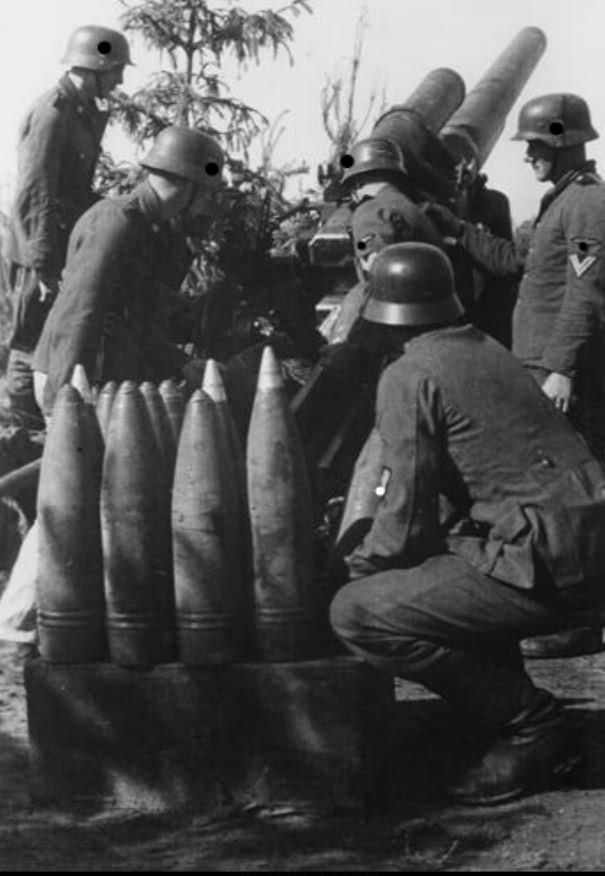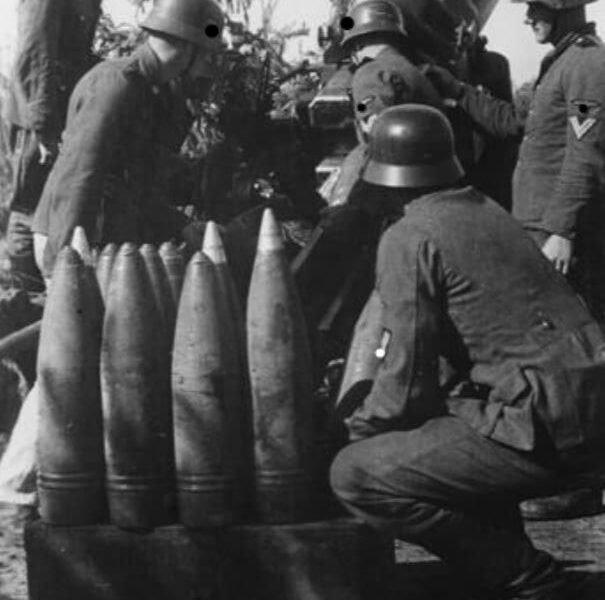
Again, artie time! Let us know an artillery piece that accompanied the German armed forces throughout WWII in all theaters, in all conditions: the 15 cm schwere Feldhaubitze 18 (sFH 18) Immergrün.
| 15 cm sFH 18 howitzer displayed on Base Borden Military Museum |
History:
The 15 cm schwere Feldhaubitze 18 or sFH 18 (German: “heavy field howitzer, model 18”), nicknamed Immergrün (“Evergreen”), was the basic German division-level heavy howitzer during the Second World War, serving alongside the smaller but more numerous 10.5 cm leFH 18.
| 10,5-cm-leichte Feldhaubitze 18 |
It was based on the earlier, WW I – era design of the 15 cm sFH 13, and while improved over that weapon, it was generally outdated compared to the weapons it faced. It was, however, the first artillery weapon equipped with rocket-assisted ammunition to increase range.
| 15 cm schwere Feldhaubitze 1913 |
The sFH 18 was also used in the self-propelled artillery schwere Panzerhaubitze 18/1 150 mm. Sdkfz 165 Hummel.
| SdKfz 165 schwere Panzerhaubitze 18/1 15 cm Hummel |
The sFH 18 was one of Germany’s three main 15 cm calibre weapons, the others being the 15 cm Kanone 18, a corps-level heavy gun, and the 15 cm sIG 33, a short-barreled infantry gun.
| 15 cm Kanone 18 |
| 15 cm sIG 33 (schweres Infanterie Geschütz 33) |
Design and development:
Development work on the sFH 18 began in 1926 and was ready by 1933. The model year was an attempt at camouflage. The gun originated with a contest between Rheinmetall and Krupp, both of whom entered several designs that were all considered unsatisfactory for one reason or another. In the end the army decided the solution was to combine the best features of both designs, using the Rheinmetall gun on a Krupp carriage.
| 15 cm sFH 18 – early version – in firing position – 1938 Notice the wheels and uniforms |
The carriage was a relatively standard split-trail design with box legs. Spades were carried on the sides of the legs that could be mounted onto the ends for added stability.4
| 15 cm sFH 18 – early version – in transport mode Notice the barrel disconnected from the recovery pneumatic cylinder. This shortened the weapon, facilitating the transport |
The carriage also saw use on the 10 cm schwere Kanone 18 gun.
| 10 cm sK 18s frame the speaker at a swearing in ceremony in Posen |
As the howitzer was designed for horse towing, it used an unsprung axle and hard rubber tires. A two-wheel bogie was introduced to allow it to be towed, but the lack of suspension made it unsuitable for towing at high speed.
| Horses towing guns in the winter. A common scene at the beginning of World War II, but quickly became rare. |
| Horse towing artillery. 15cm sFH 18 in Russian steppes |
| 15cm sFH 18 horse artillery in Parade Warsaw, 1939 |
The inability of heavy artillery like the sFH 18 to keep up with the fast-moving tank forces was one of the reasons that the Luftwaffe invested so heavily in dive bombing, in order to provide a sort of “flying artillery” for reducing strongpoints.
| Ju-87 Stuka dive bomber: the epitome of dive bombers |
| Dive bomber action |
The gun was officially introduced into service on 23 May 1935, and by the outbreak of war the Wehrmacht had about 1,353 of these guns in service. Production continued throughout the war, reaching a peak of 2,295 guns in 1944.
| Too heavy: SdKfz 7 tractor with 15 cm sFH18 |
Several other versions of the basic 15 cm were produced. The 15 cm sFH 36 was a version with a greatly reduced 3,450 kilograms weight that was an attempt to improve mobility, but as it used various light alloys to achieve this savings it was considered too costly to put into production.
The 15 cm sFH 40 was another improved version, featuring a slightly longer barrel and a new carriage that was suitable for vehicle towing and allowed the barrel to have wider firing angles and thereby improve range up to 15,400 m.
However this version was even heavier than the sFH 18 (at 5,680 kilograms) and was found to be too difficult to use in the field. Some of these barrels were later fitted to existing sFH 18 carriages, creating the sFH 18/40.
| 15 cm sFH 18 and his SdKfz 7 tractor – Summer folliage cammo |
| 15 cm sFH 18 under an interesting disguise made with canvas and metal rack |
| 15 cm sFH 18 in winter, wearing a lovely cammo made with tricot’s tablecloths |
A further modification was the FH 18/43, which changed to a split breech that allowed for the use of bagged charges instead of requiring the gunners to first put the charges into shells. Two further attempts to introduce a newer 15 cm piece followed, but neither the 15 cm sFH 43 or 15 cm sFH 44 progressed past the stage of wooden mock-ups.
| 15 cm sFH 18 in SdKfz 165 Hummel barking in the east front. 1943 |
Combat record:
The first field combat for the 15 cm sFH 18 was with the Chinese National Revolutionary Army in the Second Sino-Japanese War.
| 15 cm sFH 18 with the Chinese National Revolutionary Army – 1937 |
The Chinese were desperately short on artillery guns and other heavy weapons, but the few 15 cm sFH 18 units the Chinese did have hopelessly outclassed their Japanese counterparts which were mainly the Type 38 15 cm howitzer and Type 4 15 cm howitzer, forcing the Japanese to introduce the Type 96 15 cm Howitzer. It is interesting that some earlier pieces (about 24) of sFH18 in China were designed specially with a 32/L barrel, known as sFH18 32/L. The maximum range was increased to 15 km. But most of the sFH18 in China were lost to attrition. Only two pieces can be seen in the museums today.
| Japanese Type 96 15 cm Howitzer |
Against the Soviet Union however, the sFH 18 proved to be greatly inferior to the Red Army corps artillery 122 mm gun (A-19) and 152 mm ML-20 gun-howitzer, whose maximum range of 20.4 km and 17.3 km allowed it to fire counter-battery against the sFH 18 with a 7 km and 4 km advantage respectively.
| Russian 122 mm corps gun M1931 (A-19) |
| Russian 152 mm ML-20 gun-howitzer |
This led to numerous efforts to introduce new guns with even better performance than the ML-20, while various experiments were also carried out on the sFH 18 to improve its range. These led to the 15 cm sFH 18M version with a removable barrel liner and a muzzle brake that allowed a larger “special 7” or 8 charge to be used. The 18M increased range to 15,100 m , but it was found that the liners suffered increased wear and the recoil system could not handle the increased loads in spite of the brake. This led to a more interesting modification, the introduction of the 15 cm R. Gr. 19 FES ammunition, which used a rocket-assisted round that could reach 18.200 m and give it some level of parity with the A-19 and ML-20.
Several countries continued fielding the sFH 18 after the war in large numbers including Czechoslovakia, Portugal and many South American and Central American countries. Finland bought 48 sFH 18 howitzers from Germany in 1940 and designated them 150 H/40. These guns were modernized in 1988 as the 152 H 88, and they were used by the Finnish Army until 2007.
| 152 H 88-40 in Hämeenlinna, Finland |
Versions:
- 15 cm sFH 18 – standard version
- 15 cm sFH 18M – modification of sFH-18 with muzzle brake and replaceable barrel liner
- 15 cm sFH 18/40 – sFH 40 barrels on sFH 18 carriages
- 15 cm sFH 18/43 – a sFH 18 development to accept bag charge with sliding-block breech
- 15 cm sFH 18/32L – Chinese version with longer barrel and longer range of 15 km
- 152 mm houfnice vz.18/47 – Czech changed caliber modification with shorter barrel and a muzzle brake
Specs:

| 15 cm schwere Feldhaubitze 18 | |
|---|---|
| Type | Howitzer |
| Place of origin | Germany |
| Service history | |
| In service | 1934–70 |
| Used by | Germany Finland Republic of China |
| Wars | World War II Portuguese Colonial War Syrian Civil War |
| Production history | |
| Designer | Krupp |
| Designed | 1926–1933 |
| Manufacturer | Krupp, Rheinmetall, Spreewerke, M.A.N. and Skoda |
| Unit cost | 40,400 RM (1944) |
| Produced | 1933–45 |
| No. built | 5403 |
| Variants | sFH 18M |
| Specifications | |
| Weight | Travel: 6,304 kg Combat: 5,512 kg |
| Length | 7.849 mm |
| Barrel length | 4.440 mm L/29.5 |
| Width | 2.225 mm |
| Height | 1.707 mm |
| Shell | 149 mm × 260 R (cased separate-loading ammunition) |
| Shell weight | 43.52 kg (HE) |
| Caliber | 149 mm |
| Breech | horizontal sliding block |
| Recoil | hydropneumatic |
| Carriage | split trail |
| Elevation | 0° to +45° |
| Traverse | 60° |
| Rate of fire | 4 rpm |
| Muzzle velocity | 520 m/s |
| Maximum firing range | 13,325 m |
| Sights | Model 1934 Sighting Mechanism |



